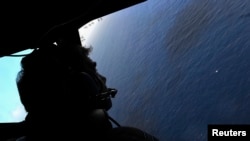BANGKOK —
The air search for debris from a missing airliner in the Indian Ocean is ending Monday, and Australian officials are dampening expectations that a soon-to-be enlarged search of the ocean’s floor is likely to quickly spot any wreckage from the missing Malaysia Airlines jet.
Australia’s prime minister, Tony Abbott, said he is “baffled and disappointed” that searchers have not been able to find MH370.
Abbott, speaking to reporters Monday in Canberra, announced that an expanded underwater area will be combed to try to find any remains of the airliner missing since March 8.
"It is highly unlikely at this stage that we will find any aircraft debris on the ocean surface. By this stage, 52 days into the search, most material would have become waterlogged and sunk. Therefore, we are moving from the current phase to a phase which is focused on searching the ocean floor over a much larger area," said Abbott.
That, according to the prime minister, is an area 700 kilometers long and 80 kilometers wide.
Abbott said Australia will seek contributions from other countries to help share the cost of using new equipment for the search in an area where the ocean’s depth reaches seven kilometers.
The search - the most expensive in aviation industry - besides Australia, has also involved equipment and personnel from Britain, China, Japan, Malaysia, New Zealand, South Korea and the United States.
Weeks of scouring the bottom of the ocean in a 400-square kilometer area, where acoustic signals from the plane’s black boxes were said to have been detected utilizing a U.S. Navy robotic submarine has turned up no trace of the Boeing 777 jetliner.
Using equipment in the deep sea to survey the larger area is a daunting task.
Angus Houston, the head of the search effort, said “if everything goes perfectly” the extended underwater search will take eight months to complete.
For unknown reasons, the Malaysian airliner veered far off course on a flight from Kuala Lumpur to Beijing. The plane was carrying 239 passengers and crew.
No trace of the aircraft has been found despite an extensive search with aircraft and boats, in addition to the Bluefin-21 submersible.
Analysis of routine data sent to satellites by the plane’s engines determined that the jet likely ran out of fuel off the western coast of Australia in one of the most remote places in the world.
The Australian prime minister, directing comments at the anguished, mostly Chinese families of the missing, said everything humanly possible will be done to solve the mystery.
“We will not let people down. And while the search will be moving to a new phase in coming weeks, it certainly is not ending," said Abbott.
However, Abbott also acknowledges it is possible nothing will ever be found of the missing airliner.
Australia’s prime minister, Tony Abbott, said he is “baffled and disappointed” that searchers have not been able to find MH370.
Abbott, speaking to reporters Monday in Canberra, announced that an expanded underwater area will be combed to try to find any remains of the airliner missing since March 8.
"It is highly unlikely at this stage that we will find any aircraft debris on the ocean surface. By this stage, 52 days into the search, most material would have become waterlogged and sunk. Therefore, we are moving from the current phase to a phase which is focused on searching the ocean floor over a much larger area," said Abbott.
That, according to the prime minister, is an area 700 kilometers long and 80 kilometers wide.
Abbott said Australia will seek contributions from other countries to help share the cost of using new equipment for the search in an area where the ocean’s depth reaches seven kilometers.
The search - the most expensive in aviation industry - besides Australia, has also involved equipment and personnel from Britain, China, Japan, Malaysia, New Zealand, South Korea and the United States.
Weeks of scouring the bottom of the ocean in a 400-square kilometer area, where acoustic signals from the plane’s black boxes were said to have been detected utilizing a U.S. Navy robotic submarine has turned up no trace of the Boeing 777 jetliner.
Using equipment in the deep sea to survey the larger area is a daunting task.
Angus Houston, the head of the search effort, said “if everything goes perfectly” the extended underwater search will take eight months to complete.
For unknown reasons, the Malaysian airliner veered far off course on a flight from Kuala Lumpur to Beijing. The plane was carrying 239 passengers and crew.
No trace of the aircraft has been found despite an extensive search with aircraft and boats, in addition to the Bluefin-21 submersible.
Analysis of routine data sent to satellites by the plane’s engines determined that the jet likely ran out of fuel off the western coast of Australia in one of the most remote places in the world.
The Australian prime minister, directing comments at the anguished, mostly Chinese families of the missing, said everything humanly possible will be done to solve the mystery.
“We will not let people down. And while the search will be moving to a new phase in coming weeks, it certainly is not ending," said Abbott.
However, Abbott also acknowledges it is possible nothing will ever be found of the missing airliner.












